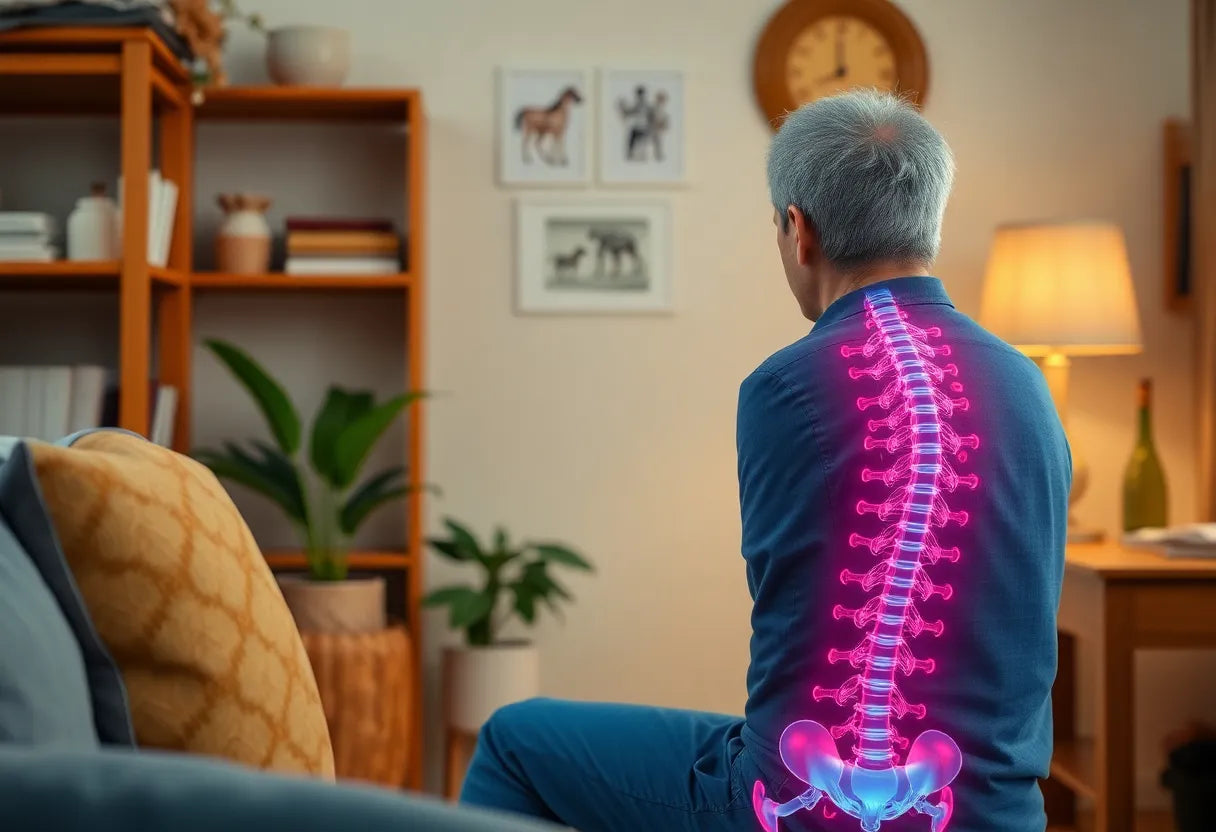Back pain is a common ailment that affects millions of people worldwide, impacting daily activities and overall quality of life. Whether it's a dull ache from sitting too long or a sharp pain from an unexpected movement, back pain can be more than just a minor inconvenience. Understanding the symptoms is crucial for addressing the issue before it becomes a chronic problem. Early recognition of these symptoms not only helps in managing pain more effectively but also in preventing potential complications.
types of back pain
Back pain can generally be categorized into two main types: mechanical and inflammatory. Mechanical back pain, the more prevalent of the two, typically arises from the spine, muscles, ligaments, or other structures in the back. It's often the result of poor posture, repetitive movements, or physical stress. On the other hand, inflammatory back pain is less common and is associated with systemic inflammation, often linked to conditions such as ankylosing spondylitis.
Identifying the root cause of back pain is essential for effective treatment. Mechanical pain might be relieved with physical therapy, ergonomic adjustments, or lifestyle changes, while inflammatory pain may require medical intervention and specific medications. Understanding these differences is key to addressing the pain appropriately and avoiding unnecessary treatments.
the significance of early detection
Spotting the signs of back pain early can lead to better health outcomes. When recognized promptly, many back pain issues can be managed effectively, reducing the risk of chronic pain and disability. It's important to be aware of "red-flag" symptoms that may indicate a more serious condition requiring immediate medical attention. These symptoms include severe night pain, unexplained weight loss, fever, or neurological symptoms such as numbness or weakness.
By paying attention to these warning signs and seeking professional evaluation when necessary, individuals can take proactive steps towards managing their back pain effectively. Early intervention not only alleviates pain but also improves overall health and quality of life.
common symptoms of back pain
Back pain manifests in various ways, often making it challenging to pinpoint the exact cause without a detailed examination. Among the most common symptoms is local pain, which can range from a dull ache to sharp, stabbing sensations. This type of pain may be constant or intermittent, frequently exacerbated by movement or particular postures.
Another prevalent symptom is radiating pain. This occurs when pain extends beyond the back into areas such as the buttocks, legs, hips, or even the abdomen. Such pain often suggests nerve involvement, indicating that the issue might stem from conditions like a herniated disc or sciatica.
Stiffness is also a typical symptom, particularly noticeable in the morning or after periods of inactivity. While stiffness can often be relieved with movement, persistent or severe stiffness might indicate an underlying inflammatory condition.
worsening and systemic symptoms
Activities that involve lifting, bending, or twisting can exacerbate back pain, especially when it is mechanical in nature. Such worsening on movement is a clear indicator that the pain might be due to strain or injury to the back's structural components.

Lumbar support belt
Stabilizes and relieves your lower back; adjustable and suitable for daily use.
In contrast, systemic symptoms like fever, unexplained weight loss, or recent trauma are red flags that warrant immediate medical evaluation. These symptoms could suggest serious conditions such as infections, malignancies, or other systemic diseases that require prompt attention.
red-flag symptoms
Certain symptoms are considered "red flags" due to their potential to indicate serious underlying conditions. One such symptom is night pain, which is severe enough to disturb sleep. This type of pain can be a sign of malignancy or infection, necessitating further investigation.
Additionally, neurological symptoms such as numbness, weakness, or loss of bladder or bowel control are critical indicators of possible nerve damage or conditions like cauda equina syndrome. These symptoms require urgent medical intervention to prevent permanent damage.
visual aid: symptom severity chart
To assist in understanding the severity of back pain symptoms, a visual aid such as a symptom severity chart can be invaluable. This chart categorizes symptoms by their intensity and suggests corresponding actions, helping individuals determine when to seek professional help. By visually mapping out symptoms, patients can more easily identify patterns and decide on the best course of action.
Recognizing and understanding these symptoms is crucial for effective management and treatment of back pain. Early detection and intervention can significantly improve outcomes, reducing the risk of chronic pain and enhancing overall quality of life. By staying informed and vigilant, individuals can take proactive steps to address back pain and seek appropriate care when necessary.
when to seek professional help for back pain
Recognizing when back pain requires professional evaluation is crucial for effective management and prevention of serious complications. A clinical evaluation typically begins with a thorough history-taking and physical examination. These initial steps help identify the nature of the pain, its triggers, and any associated symptoms that might suggest a more serious underlying condition.
In some cases, further diagnostic tools such as imaging studies (e.g., X-rays, MRIs) or laboratory tests (e.g., ESR, CRP) are necessary to confirm the diagnosis or rule out specific conditions. These tests can be particularly useful in differentiating between mechanical and inflammatory causes of back pain.
Understanding the criteria for differentiating routine back pain from more serious causes is essential. For instance, the ASAS criteria are often used to identify inflammatory back pain, which can present with symptoms like pain that improves with exercise, occurs at night, and does not improve with rest. Recognizing these patterns helps determine when a specialist evaluation is warranted.
practical self-management tips for back pain
While professional evaluation is important, there are several self-management strategies that individuals can implement to alleviate back pain and prevent future episodes. Ergonomic solutions, such as adjusting chair height, using lumbar supports, and ensuring proper posture, play a significant role in managing and preventing back pain.

Men's Posture Shirt™ - Black
Patented shirt for posture correction; activates muscles and relieves pain and tension.
Lifestyle adjustments are equally important. Regular exercise, particularly activities that strengthen the core and improve flexibility, can help reduce the risk of back pain. Maintaining a healthy weight and managing stress through techniques such as mindfulness or yoga can also contribute to overall back health.
Frequently Asked Questions
What are the first signs of concerning back pain?
Initial signs of concerning back pain include persistent pain that does not improve with rest, pain that radiates to other parts of the body, and accompanying symptoms such as numbness or weakness. If any of these symptoms are present, it's advisable to seek medical evaluation.
How can I differentiate between mechanical and inflammatory back pain?
Mechanical back pain is often associated with physical activities and is relieved by rest, while inflammatory back pain typically improves with exercise and may worsen at night. Inflammatory back pain is also more likely to be accompanied by systemic symptoms such as fatigue or fever.
When should back pain be considered an emergency?
Back pain should be considered an emergency if it is accompanied by red-flag symptoms such as loss of bladder or bowel control, severe night pain, or significant neurological deficits like numbness or weakness in the legs. These symptoms may indicate serious conditions requiring immediate medical attention.
What lifestyle changes can help manage back pain?
Lifestyle changes that can help manage back pain include maintaining a regular exercise routine, focusing on core strengthening, practicing good posture, and using ergonomic furniture. Additionally, maintaining a healthy weight and reducing stress can contribute to overall back health.
Can back pain be a sign of something more serious?
Yes, back pain can sometimes be a sign of more serious conditions such as infections, malignancies, or neurological disorders. Persistent or severe pain, especially when accompanied by red-flag symptoms, should prompt further medical evaluation to rule out these conditions.
Källor
- National Institute of Arthritis and Musculoskeletal and Skin Diseases. "Back Pain."
- Cleveland Clinic. "Back Pain."
- MedlinePlus. "Back Pain."
- American Dental Association. "Symptoms and Causes of Back Pain."
- University of Maryland Medical System. "Signs and Symptoms of Spine Conditions."
- World Health Organization. "Low Back Pain."
- Holy Cross Health. "6 Back Symptoms You Should Never Ignore."
- Harvard Health Publishing. "Back Pain."


















